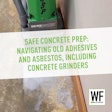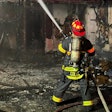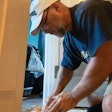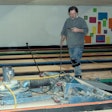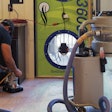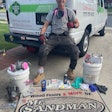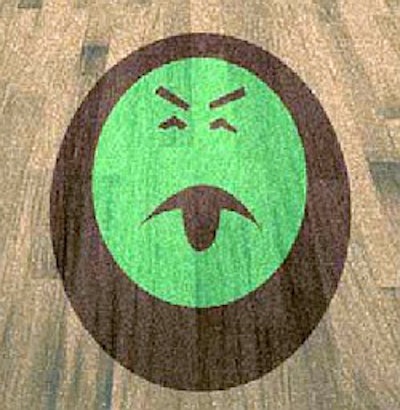
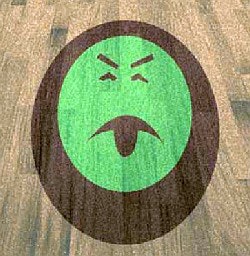
There are many hazards associated with the hardwood flooring industry. Power tools, electrical hook-ups and heavy lifting pose an everyday threat. What many contractors don't realize is that other intangible dangers may lie beneath the surface. Evil culprits like lead and asbestos can lie harmlessly on a floor, but pose serious health risks when disturbed through sanding. With the increasing popularity of renovating older homes, including ripping up old tile to expose original wood flooring, dealing with these deadly toxins should be a priority for wood flooring contractors.
Many contractors, however, aren't aware of the risks or don't want to deal with the hassles, which include informing the home owner and properly removing these substances. "People in our industry have ignored this problem and would like to continue to ignore it," says Bob Ikens, owner of Ikens Hardwood Floors in Madison, Wis. Some contractors are hesitant to inform the customer that a potential health hazard may exist — it's a lot easier to just do the job, collect the check and be on your way. The risk is in exposing your workers and the occupants to these toxins. Not only do you have a moral obligation to them, you could also be held liable if they develop health problems later from exposure to lead or asbestos. The first step is recognizing what possible health hazards exist, then testing for them and taking necessary precautions to keep them contained.
Lead, Asbestos and Wood Dust: Yuck!
If lead poisoning can spur the fall of the Roman Empire, as historians have speculated, imagine what it could do to your contracting business. Workers are exposed to lead through inhalation of lead-containing dust and fumes or through ingesting lead-contaminated surfaces. Lead poisoning is especially a concern for young children who tend to get their hands and mouths into everything. Overexposure to lead can cause kidney damage, anemia, high blood pressure, infertility and impotence.
Most remodelers and do-it-yourselfers are aware of the risks involved when working with lead-based paint, which is common in older buildings. What many wood floor professionals don't realize is that older floor varnishes may also contain lead. Before 1978, lead was used in many of the clear coats with drying agents, such as lead acetate. "There is a risk here, and varnish, from a legal point of view, can be considered lead-based paint," says Joe Schirmer, public health educator with the Wisconsin State Division of Public Health. Federal law defines lead-based paint as paint or other surface coatings that contain lead of 5,000 parts per million (ppm) or 1 milligram per square meter. "Included in the language of the law passed in 1992 is the concept that lead can exist in surface coatings other than paint, including varnish, which is often overlooked, "Schirmer says. And, even though a floor may initially contain acceptable lead levels, sanding can create enough dust to fail the federal lead clearance standards.
Schirmer cites a case where a child suffered lead poisoning by gnawing on a wood floor coated with varnish. He speculates that even though the floor varnish contained amounts of lead that were within the federal limit, once the floo was sanded, the child was exposed to higher amounts of lead. While this maybe an extreme case, it's possible for poisoning to occur and, inevitably, a lawsuit.
Just about everyone is aware of the nasty "A" word in construction: asbestos. Asbestos was a popular building material for most of the last century until the adverse health effects were discovered. It was common in building materials such as asphalt and vinyl floor tile, vinyl sheet flooring, floor backing, construction mastics, insulation and adhesives.
Asbestos is only dangerous if it becomes airborne and is inhaled over a period of time. The small fibers accumulate in the lungs and eventually can cause diseases such as asbestosis, a scarring of the lung tissue; mesothelioma, cancer of the lining of the lung; and lung cancer. Even worse news for the many contractors who smoke is that asbestos exposure and smoking combined increase the risk of lung cancer 50 to 90 times more than a contractor who doesn't light up. These diseases can remain latent for 15 to 40 years before symptoms occur. In fact, more people today are dying from asbestos-related diseases as the effects of their work practices from 40 years ago become evident. The Occupational Safety and Health Administration (OSHA) Permissible Exposure Limit for asbestos is 0.1 fibers per cubic centimeter, however,the Environmental Protection Agency (EPA) has determined that there is no safe level of exposure to asbestos fibers.
While lead and asbestos pose serious health consequences, the clear and present danger for wood flooring contractors is from wood dust. Usually ignored, wood dust from sanding and buffing is a serious health risk once inhaled. Generally, the dust from hardwoods is more hazardous than that from softwoods and can cause maladies such as eye and skin irritation, allergies, reduced lung function, asthma and nasal cancer. Again, smoking coupled with wood dust exposure further increases the likelihood of developing a lung condition or disease.
The OSHA Permissible Exposure Limit for wood dust is 15 milligrams per cubic meter; however, the National Institute for Occupational Safety and Health (NIOSH) designates wood dust as a possible carcinogen and has a Recommended Exposure Limit of one milligram per cubic meter. "Flooring contractors are concerned about lead and other toxins; I'd be most concerned about wood dust," says Aaron Sussell, an industrial hygienist at NIOSH. Sussell did a study on Ikens Hardwood Floors to determine the amount of lead exposure on a job site. Having never witnessed professional floor sanding before, Sussell was shocked to see the amount of wood dust produced. He was even more surprised that Ikens was more concerned about lead exposure.
Yuck Patrol

The first step in determining what's on the floor is to find out the history of the home. Get as much information from the home owner as possible. Ask when the floor was sanded last. If it hasn't been sanded since 1980, there's a good chance the floor varnish may contain lead. In 1978, manufacturers of varnish stopped using lead, but a good rule of thumb is to allow for a two-year shelf life on these products. The older the varnish, the more likely it's going to contain lead — some may have up to 1 percent lead content.
Another concern with older homes is removing tile or linoleum to expose wood floors beneath. Many of these products contain asbestos or have mastic or adhesive with asbestos. Again, knowing the history of the home and the floors is essential. Vinyl floor tiles manufactured as recently as 1986 may contain asbestos. Nine-by-9-inch square tiles often contain asbestos, but looks alone won't tell you what's on the floor. If possible, contact the linoleum manufacturer for specific information. The bottom line is that if you don't know the history of the floor, you need to take precautions and find out exactly what you're dealing with.
Take the Yuck Test
If you suspect there are hazardous materials in the floor, have it tested. Take a scrape sample for lead and send it in to your state's department of health or another lab that can test for lead content. The test usually costs only between $20and $40, and most home owners will gladly absorb the cost to have peace of mind. Once you get the results, determine if the lead content is within federal and state regulations. To be considered lead based paint, the federal standard is 0.5 percent lead (or 5,000 ppm), but several states have more stringent levels of acceptability, and you always need to follow the stricter standard. The Consumer Products Safety Commission's standard is 0.06 percent (or 600 ppm). According to EPA guidelines, if the surface is lead–based and it's over two square feet, you must hand out a lead information pamphlet to the home owners and have them sign a form indicating you gave them the information and that you will be disturbing a leaded surface.
Testing for asbestos can be a little more tricky. As a contractor, if you're not certified in asbestos inspection, you cannot take your own sample. In some states, a home owner is allowed take a sample and have it tested for around $20. In other states, this practice is illegal. To avoid this confusion and to help with estimating the job, it's a good idea for one person in your company, such as the estimator, to be a certified asbestos inspector. If asbestos is found, get a certified asbestos abatement contractor. Sanding is about the worst thing you can do to spread toxic asbestos material, and there are hefty fines for doing so. If you have multiple jobs with asbestos, you may also want to consider having a few people in your company certified in removing and working with asbestos. Before you do anything with asbestos, you need to know the specific laws in your state for testing, removing and working with asbestos. You also need to follow the OSHA Asbestos Standard.
Keep the Yuck in Check
There is no such thing as safe dust, whether it's lead, asbestos or wood. Spreading dust around the house not only creates a mess and nuisance for the home owner, and it can create a health hazard. Even with the best dust-containment systems, sanding, edging and buffing release small particles in the air. This presents a risk to workers and bystanders, as these fine particles are easily absorbed into the body through inhalation and are easily absorbed into the digestive system.
If the dust isn't properly contained and removed, the occupants, especially young children, risk ingesting the dust left behind on the floors, window sills and furniture. "You're taking a risk, because you're working in that house for eight to 10 hours for three days, but what you leave behind for the home owner is really a concern, too. You could be liable," says Ikens. Lead is heavy and settles out of the air in a few hours, but asbestos is like feathers — it can circulate through the air for weeks. Just because a floor is under the limit to be considered lead-based (one milligram per square meter) doesn't mean that it will prevent exposure. According to a 1978 study published in the New England Journal of Medicine, five minutes of sanding a floor with 0.8 to 0.9 milligrams of lead per square centimeter produced 550 micrograms of lead per cubic centimeter. The Federal OSHA standard for eight hours of sanding is 50 micrograms of lead per cubic meter.
The first step in containing the dust is to create an airtight seal and prevent the dust from seeping into adjacent areas. Hang, not drape, the plastic using non-marking tape and make it easy to get in and out of the work area. Ikens uses a zipper that he sticks to the plastic and cuts an opening with a razor knife. Close off all heat ducts and cold air returns so the dust doesn't recirculate through the house.
It's also a good idea to be diligent about thoroughly vacuuming the floors, ceilings and walls. Not only does this result in a better finished product and a clean house, it also help protects the occupants of the home. Just a tiny amount of dust on the window sill could be a potential hazard to a child and a huge liability for you. Many contractors,such as Ikens, prefer to use an industrial strength HEPA vacuum instead of a traditional upright vacuum. These vacs filter out 99.97 percent of the particles from the air that are greater than or equal to 0.3 microns. Researchers at NIOSH have also created ventilation control systems, which are still being tested, that attach to disc sanders and hand sanders.
The best way to protect workers from harmful dust is through the proper use of respirators. A comfort mask is not enough to protect he lungs — it only keeps things out of the mouth and nose. "A few contractors are starting to take a look at the hazards. We know how to control these things — the respirator is the last line of defense," Sussell says. Respirators protect workers from chronic exposure, or health problems that take many years to manifest themselves. "Who's to say what we'll learn about wood dust years from now. I wouldn't want to be the guinea pig," says Bruce Penning, market supervisor at 3M Co.'s Occupational Health and Environmental Safety Division. Respirators should be NIOSH-approved and have an N100 designation when working with lead-based materials and a P100 designation when working with asbestos. The 100 category is equivalent to a HEPA filter.
The key to providing a safe work place for workers and a safe environment for the home owner is being aware of the risks and taking precautions. There's great awareness about the dangers of equipment, but many contractors are unaware or choose to ignore the possible long-term health hazards from what seems like simple dust. "Contractors can do their job safely, they just need to take precautions and be aware of the risk,"Sussell says.
Resources
For a list of laboratories that analyze paint or varnish samples, or to get more information, call800/356-4674 or 800/424-LEAD.
Other resources for lead, asbestos, wood dust and other worker related safety issues:www.cdc.gov/nioshwww.epa.govwww.hud.govwww.osha.gov
















